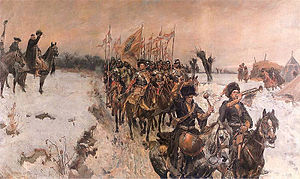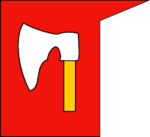Chorągiew (military unit)
- Chorągiew (military unit)
-
Chorągiew (Polish pronunciation: [xɔˈrɔŋɡʲɛf]; literally: "banner") was the basic administrative unit of the Polish cavalry from the 14th century. An alternative name until the 17th century was Rota.
The name may derive from Slavic word Khorugv (banner).
Between the 14th and 17th century the Chorągiew was composed of smaller sub-units - the so-called Poczet.
Types of Chorągiew were:
- Chorągiew ziemska (District banner), formed by knights of a district.
- Chorągiew rodowa (Clan banner), formed by clans.
- Chorągiew nadworna (Court banner), formed by troops of the King.
In the cavalry, since the second half of the 15th century until the first half of the 18th century, a Chorągiew was formed according to the "companion system" (system zaciągu towarzyskiego). See: Towarzysz (companion).
Types of Chorągiew were:
- Chorągiew husarska (Hussar banner), formed by Hussars.
- Chorągiew lekka ("Light" banner), formed by light-cavalry.
- Chorągiew pancerna ("Armoured" banner), formed by Pancerni.
- Chorągiew tatarska (Tatar banner), formed by Tatars.
- Chorągiew wołoska (Vlach banner), light cavalry, not only formed by Vlachs.
- Chorągiew kozacka (Cossack banner), formed by Cossacks.
Typical family/village clans of the Chorągiew Rodowa who provided men for battles consisting of approximately 100 men were:
Wikimedia Foundation.
2010.
Look at other dictionaries:
Guerre de Smolensk — Informations générales Date 1632–1934 Lieu Europe de l Est Issue traité de Polanów … Wikipédia en Français
Banner of Poland — Throughout most of the history of Poland, the banner of Poland was one of the main symbols of the Polish State, normally reserved for use by the head of state. Although its design changed with time, it was generally a heraldic banner, i.e., one… … Wikipedia
Marek Sobieski (1628–1652) — Marek Sobieski Coat of arms … Wikipedia
Polish cavalry — The Polish cavalry ( pl. kawaleria) can trace its origins back to the days of Medieval mounted knights. Poland had always been a country of flatlands and fields and mounted forces operate well in this environment. The knights and heavy horse… … Wikipedia
Mykhailo Krychevsky — or Stanisław Krzyczewski or Krzeczowski (died 3 August 1649) was a Polish noble, military officer and Cossack commander. Contents 1 Biography 2 In fiction 3 Notes 4 Further reading … Wikipedia
Lisowczycy — (also known as Straceńcy ( lost men or forlorn hope ) or chorągiew elearska (company of elears); or in singular form: Lisowczyk or elear) the name of an early 17th century irregular unit of light cavalry, mostly form Grand Duchy of Lithuania, as… … Wikipedia
Battle of Zhovti Vody — Infobox Military Conflict conflict=Battle of Zhovti Vody partof=the Khmelnytsky Uprising caption=Death of Stefan Potocki at the Battle of Zhovti Vody. date=April 29 May 16, 1648 place=Zhovti Vody, Ukraine result=Cossack Tatar victory combatant1=… … Wikipedia
Szare Szeregi — Grey Ranks ( pl. Szare Szeregi) was a codename for the underground Polish Scouting Association ( pl. Związek Harcerstwa Polskiego ) during World War II. The organisation was created on September 27, 1939, actively resisted and fought German… … Wikipedia
Registered Cossacks — Mail armour worn by elite regiments of registred Cossacks known as panzer Cossacks … Wikipedia
Józef Kanty Ossoliński — Infobox Szlachcic name=Józef Kanty Ossoliński caption= family=Ossoliński CoA=Topór father=Franciszek Maksymilian Ossoliński mother=Katarzyna Miączyńska consorts=Teresa Stadnicka children=Maksymilian Ossoliński Józef Salezy Ossoliński Anna Teresa… … Wikipedia


